المُلخص التنفيذي
عملية التطير بالكلور اصبحت مستخدمة على نطاق واسع في أوائل القرن العشرين. حيث انطلقت ثورة تقنية في مجال معالجة المياه واستكملت بعمليات الترشيح المعروفة والمستخدمة حاليا . فبالإضافة إلى قتل الكائنات الحية الدقيقة الضارة ،فأن الكلور أيضا يُقلل من كمية الحديد والمنجنيز وكبريتيد الهيدروجين الموجود في المياه. فالتطهيرالكيميائي باستخدام الكلور له فوائد كثيرة حيث أن ماده الكلورسريعة التطهير نسبياً وبسيطة ورخيصة وتسمح بوجود كمية متبقية من الكلور تظل في الماء لتمنع إعادة التلوث للمياه مرة اخرى.
| المُدخلات | المُخرَجات |
|---|---|
المياة العذبة |
مياه الشرب |
المقدمة
يطلق على تطهير مياه الشرب بإضافة الكلور اسم الكلورة. تم استخدام الكلور لأول مرة في عام 1850 عندما أستخدمه جون سنو في نظام توزيع المياه في لندن من أجل مكافحة الكوليرا. وبالمثل، بدأت المدن الأمريكية مثل شيكاغو ونيو جيرسي بأستخدام مادة الكلور في جميع البلدان عام 1908م ، وهي خطوة أدت إلى انخفاضًا كبيرًا في عدد الوفيات الناجمة عن الكوليرا والتيفود والإسهال والإلتهاب الكبدي أ فمنذ ذلك الوقت وحتي يومنا هذا يتم أستخدام مادة الكلور لمعالجة معظم مياه الشرب في العالم , فهو سهل وغير مكلف وموثوق فيه فقد أصبح الكلور الآن متاح على نطاق واسع وفي بلدان مختلفة مع علامات تجارية وأسماء مختلفة.
ويستخدم فى عملية الكلوره كلا من غاز الكلور المضغوط (المسال) أو محلول من هيبوكلوريت الصوديوم أو حبيبات هيبوكلوريت الكالسيوم أو مولدات الكلور فى الموقع مثل( WATA) .
يتم استخدام الكلورة للتطهير المركزي لمياه الشرب في انظمة إمدادات المياه على المستوى الحكومى . والآن نجد الهئيات الدولية تشجع معالجه المياه بالكلورة على مستوى المنزل في البلدان النامية كخيار فعال وبسيط.
الكلور المستخدم في نقاط المعالجة علي المستوي المنزلي يكون متاحا اما في صورة محلول حيث يضاف كجرعات من قطرة أو عدة قطرات لكل لتر من المياه لمعالجتها أو في صورة اقراص والتي سوف تذوب في المياه المعالجة.
. وبصرف النظر عن هذه المنتجات التجارية، فالمياه يمكن أيضًا أن تعالج على مستوى المجتمع المحلي عن طريق ضخ الكلور في خزانات المياه والآبار والأوعية المنزلية.
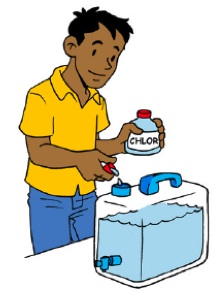
الكلورة فى مستوى المنزل المصدر: CAWST (2009)
كيفية العمل ؟
عند إضافة الكلور إلى الماء، يذوب ويتأين الى الشق الحر . هذه الشقوق تُقتل مُسببات الأمراض مثل البكتيريا والفيروسات عن طريق كسر الروابط الكيميائية في جزئياتها، أو من خلال مهاجمة خلايا الكائنات الحية الدقيقة.
فالشقوق الحرة والأيونات المختلفة المتكونة أثناء عملية الكلوره تُدمر العديد من أنواع البكتيريا والفيروسات، ولكنها أيضا تعمل علي أكسدة بعض المواد العضوية، فاختفاء اللون وتُدمر الكلورامينات، والمنتجات السامة الناتجة من التفاعل مع الأمونيا يستغرق حوالي 30 دقيقة لاستكمال هذه العمليه وجعل المياه امنة للشرب
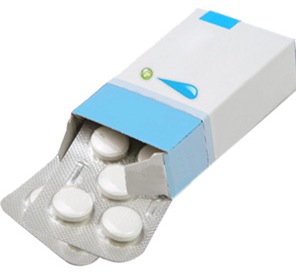
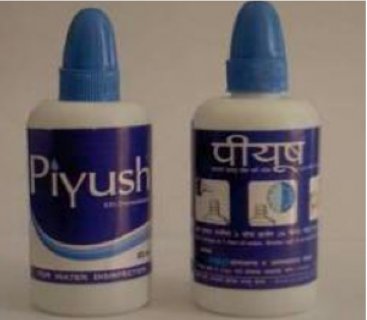
أقراص الكلور و بيوش، محلول الكلور 0.5٪ تجاريا في نيبال
إستخدام الكلور:
يجب إستخدام الكمية الصحيحة من محلول الكلور. إذا كان تركيز الكلور غير كاف قد تفشل عملية تدمير جميع الكائنات الدقيقة الضارة وعندما تزيد عن الحد اللازم ، فقد تتأثرالصحة سلبًا. فقط كمية مناسبة من الكلور يمكن أن تُدمر معظم الكائنات الدقيقة الضارة وتوفر كمية آمنة من الكلور المتبقي ويسمى الكلور الذي لا يتحد مع المكونات الأخرى ويبقى في المياه "الكلور الحر المتبقي" (الاتحاد الدولى للصليب الاحمر والهلال الاحمر ). الكلور الحر المتبقي يعمل علي التأكد من أن المياه التي تمت معالجتها عن طريق الكلورة لن يعاد تلوثها أثناء نقلها وتخزينها . وفقا لإرشادات منظمة الصحة العالمية، يجب أن يكون تركيز كميه "الكلور الحر المتبقي" في مياه الشرب يترواح ما بين 0.2 الي 0.5 مللي جرام / لتر.
الفاعلية
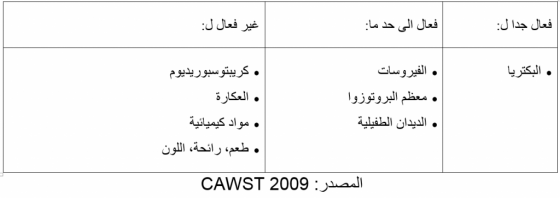
التطهير بالكلور لمياه الشرب قد يكون محدودا لمسببات الأمراض من الأوليات ( مسببات الامراض من البروتوزوا ) (وخاصة الكريبتوسبوريديوم) وبعض الفيروسات (WHO 1996). فالعكارة يمكن أن تحمي بعض الكائنات الحية الدقيقة أثناء عملية التطهير. وعلاوة على ذلك، عندما تكون المواد العضوية الطبيعية متواجدة بشكل كبير في المياة، فان ذلك يمكن أن يؤدي إلى تكون النواتج الثانوية للتطهير (DBPs) مثل الهالوجينات العضوية , وبصفة اساسية التراى هالو ميثان THM وبعض هذه المواد يُحتمل أن تكون خطرة.ومع ذلك، فإن المخاطر الصحية الناجمة عن كل هذه النواتج الجانبية للتطهير صغيرة للغاية بالمقارنة مع المخاطر المرتبطة علي عدم كفاية التطهير , فالتطهير لا يجب التقليل من عملية التطهير للسيطرة على نواتج التطهير الجانبية .(WHO 1996; WHO 2006)
ففي عام 1991، قامت الوكالة الدولية لبحوث السرطان بالتصريح بإمكانيه الأصابه بالسرطان من المياه الخاصة بالشرب المعالجه بالكلور. وأختتمت، أن "هناك أدلة غير كافية تدل علي وجود مواد مسرطنه في مياه الشرب المكلورة تؤثر في البشر". ومع ذلك، فان معدل تكوين النواتج الثانوية للتطهير مثل الهالوجينات المسرطنة يرتفع جدا في المياه التي تحتوي على كميات كبيرة من المواد العضوية، والتي تتكون نتيجة لمهاجمة الكلور للمواد العضوية - ولذلك فمن المستحسن أن تُستخدم عمليات الترشيح قبل التطهير (مثل الترشيح الرملي البطئ أو الترشيح الحيوي بالرمل).
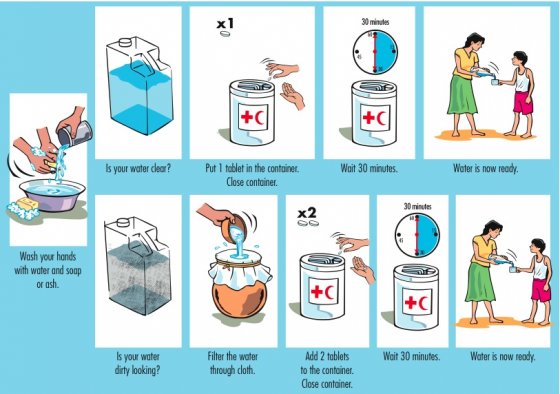
كيفية معالجة المياه بأقراص الكلور المصدر: اللجنة الدولية للصليب الاحمر والهلال الاحمر 2008
يناسب استخدام الكلورة الأماكن التي يكون فيها البشر يشربون المياه بشكل مباشر من المصادرالتي تحتوي علي الملوثات البكتيرية ولكن عندما لا تكون الملوثات الأخرى مثل (المواد العضوية الطبيعيه والزرنيخ) مثيرة للقلق.
التطهير بالكلور مقبول اجتماعيًا من قِبل الجمهورمن أجل تنقية المياه وذلك بسبب سهولة التداول، وفعالية التكاليف، وكذلك الازالة الجيدة للكائنات الميكروبية من مياه الشرب. كما أن استخدامه يعتبر الشكل الأكثر شيوعًا لتطهير المياه في حالات الطوارئ. (IFRC 2008; CDC/USAID 2008; WHO n.y.) . ولذلك، فيجب ضمان إمدادات ثابتة من الكلور.
Filtration & Chlorination Systems
Introduction to filtration and chlorination systems at the household level.
CDC/USAID (2009): Filtration & Chlorination Systems . (= CDC Household Water Treatment Options in Developing Countries Factsheets ). New York: Center for Disease Control and Prevention (CDC) and United States Agency for International Development (USAID). [Accessed: 01.04.2010] PDFChlorine in water disinfection
This article contains information on safe drinking water, and explains the benefits and risks of chlorination.
GORCHEV, G.H. (1996): Chlorine in water disinfection. المُدخلات: Pure & Applied Chemistry: Volume 68 , 1731-1735. URL [Accessed: 19.05.2010]IARC monographs on the evaluation of carcinogenic risks to humans. Chlorinated drinking-water; chlorination by-products; some other halogenated compounds; cobalt and cobalt compounds
Household water treatment and safe storage in emergencies
This document is intended as a general manual on household water treatment and storage in emergencies. Methods of treatment but also promotion are presented, including factsheets, a decision tree and very comprehensive illustrations.
IFRC (2008): Household water treatment and safe storage in emergencies. pdf presentation. Geneva: International Federation of Red Cross and Red Crescent Societies (IFRC) URL [Accessed: 23.04.2012]Household Water Treatment and Safe Storage Following Emergencies and Disasters
A six-pages compilation about what to do in emergency situations. Designated to the South Asia earthquake and tsunami.
WHO (n.y): Household Water Treatment and Safe Storage Following Emergencies and Disasters. pdf presentation. Geneva: World Health Organisation (WHO) URL [Accessed: 17.05.2019]Guidelines for Drinking-Water Quality, Second Edition
This volume of the WHO guidelines for drinking-water quality explains how guideline values for drinking-water contaminants are to be used, defines the criteria used to select the various chemical, physical, microbiological, and radiological contaminants included in the report, describes the approaches used in deriving guideline values, and presents, in the form of brief monographs, critical reviews and evaluations of the effects on human health of the substances or contaminants examined.
WHO (1996): Guidelines for Drinking-Water Quality, Second Edition. (= Health Criteria and Other Supporting Information - Second Edition , 2 ). Geneva: World Health Organization (WHO) URL [Accessed: 31.03.2010]Guidelines for Drinking-water Quality. FIRST ADDENDUM TO THIRD EDITION
This volume of the Guidelines for Drinking-water Quality explains requirements to ensure drinking-water safety, including minimum procedures and specific guideline values, and how those requirements are intended to be used. The volume also describes the approaches used in deriving the guidelines, including guideline values. It also includes fact sheets on significant microbial and chemical hazards.
WHO (2006): Guidelines for Drinking-water Quality. FIRST ADDENDUM TO THIRD EDITION. Geneva: World Health Organization (WHO) URL [Accessed: 19.01.2011]ﺍﻟﻤﻴﺎﻩ, ﻤﻴﺎﻩ ﺍﻟﺸﺭﺏ. ﺍﻹﺼﺩﺍﺭ ﺍﻟﺨﺎﻤﺱ,ﺍﻟﻤﻤﻠﻜﺔ ﺍﻷﺭﺩﻨﻴﺔ ﺍﻟﻬﺎﺸﻤﻴﺔ.
Language: Arabic
التقييم النوعي لمياه الشرب المعبأة في العراق,منطقة الفرات الأوسط. مجلة جامعة بابل/ العلوم الصرفة والتطبيقية, العدد(1),المجلد(23).جامعة بابل.العراق.
Language: Arabic
اﺳﺗﺧدام اﻟﻣؤﻛﺳدات اﻷﺧرى ﻓﻲ ﺗطﻬﻳر اﻟﻣﻳﺎﻩ. اﺳﺗﺧدام اﻷوزون,ﺑﻳروﻛﺳﻳد اﻟﻬﻳدروﺟﻳن , ﺛﺎﻧﻲ أوﻛﺳﻳد اﻟﻛﻠور. قسم الھندسة البيئية,كلية الھندسة المدنية , جامعة دمشق.
Language: Arabic
تطھير المياه. تطھير المياه باستخدام المؤكسدات القوية (الكلورة) . قسم الھندسة البيئية,كلية الھندسة المدنية , جامعة دمشق.
Language: Arabic
ﺩﻟﻴﻞ ﺧﻄﺔ ﺳﻼﻣﺔ ﺍﻟﻤﻴﺎﻩ. ﺩﻟﻴﻞ ﻣﻔﺼﻞ ﻹﺩﺍﺭﺓ ﺍﻟﻤﺨﺎﻃﺮ ﻟﻤﻘﺪﻣﻲ ﻣﻴﺎﻩ ﺍﻟﺸﺮﺏ.جينف:منظمة الصحة العالمية.
يهدف هذا الدليل إلى تقديم الإرشاد العملي، لتسهيل تطوير خطة سلامة المياه، مع التركيز على إمدادات المياه المنظمة التي تديرها منشأة مياه أو ما شابه.
منظمة الصحة العالمية,الإتحاد الدولي للمياه (2009): ﺩﻟﻴﻞ ﺧﻄﺔ ﺳﻼﻣﺔ ﺍﻟﻤﻴﺎﻩ. ﺩﻟﻴﻞ ﻣﻔﺼﻞ ﻹﺩﺍﺭﺓ ﺍﻟﻤﺨﺎﻃﺮ ﻟﻤﻘﺪﻣﻲ ﻣﻴﺎﻩ ﺍﻟﺸﺮﺏ.جينف:منظمة الصحة العالمية.. URL [Accessed: 26.08.2017]Language: Arabic
ﺍﻟﻤﺎﺀ ﺍﻟﺨﺎﻡ ﻭﻤﺎﺀ ﺍﻟﺸﺭﺏ ﻓﻲ ﻤﺤﺎﻓﻅﺔ ﺒﺎﺒل ﺩﺭﺍﺴﺔ ﻭﺘﺤﻠﻴل. جامعة بابل. العراق.
Language: Arabic
ﺩﻻﺌل ﺠﻭﺩﺓ ﻤﻴﺎﻩ ﺍﻟﺸﺭﺏ.جينيف.سويسرا
ﺠﻭﺩﺓ ﻤﻴﺎﻩ ﺍﻟﺸﺭﺏ ﺍﻟﻤﻌﺒﺄﺓ ﺍﻟﻤﺤﻠﻴﺔ ﻭﺍﻟﻤﺴﺘﻭﺭﺩﺓ ﻓﻲ ﺍﻟﻤﻤﻠﻜﺔ ﺍﻟﻌﺭﺒﻴﺔ ﺍﻟﺴﻌﻭﺩﻴﺔ.ﺠﺎﻤﻌﺔ ﺍﻟﻤﻠﻙ ﺴﻌﻭﺩ, ﻤﺠﻠﺔ ﺠﺎﻤﻌﺔ ﺍﻟﻤﻠﻙ ﻋﺒﺩ ﺍﻟﻌﺯﻴﺯ: ﺍﻟﻌﻠﻭﻡ ﺍﻟﻬﻨﺩﺴﻴﺔ، ﻡ 14، ﻉ 2، ﺹ ﺹ 1423) 104-81ﻫـ / 2002ﻡ). ﺍﻟﻤﻤﻠﻜﺔ ﺍﻟﻌﺭﺒﻴﺔ ﺍﻟﺴﻌﻭﺩﻴﺔ.
Language: Arabic
AUTARCON SuMeWa System
Powerpoint presentation of the water purification system implied by AUTARCON. This system uses solar energy to realise mechanical filtration and chlorification of water.
AUTARCON (2012): AUTARCON SuMeWa System. SolarPV Driven-Drinking Water Treatment. Munich: AUTARCON, Sun Meets Water (SuMeWa) System. [Accessed: 18.07.2017] PDFDisinfecting your well water: Shock Chlorination, Housing and Environment
This article describes how to use shock chlorination safely and effectively.
ATILES, J.H. VENDRELL, P.F. (2003): Disinfecting your well water: Shock Chlorination, Housing and Environment. Georgia: The University of Georgia URL [Accessed: 19.05.2019]Chlorine (NaDCC Tablets)
Factsheet on chlorination with NaDCC tablets.
CAWST (2009): Chlorine (NaDCC Tablets). (= Household Water Treatment and Safe Storage Fact Sheets – Academic ). Alberta: Center for Affordable Water and Sanitation Technology (CAWST) URL [Accessed: 19.05.2019]Chlorine (Sodium Hypochlorite)
Factsheet on chlorination with sodium hypochlorite solutions.
CAWST (2009): Chlorine (Sodium Hypochlorite). (= Household Water Treatment and Safe Storage Fact Sheets – Academic ). Alberta: Center for Affordable Water and Sanitation Technology (CAWST) URL [Accessed: 19.05.2019]Household Water Treatment Options in Developing Countries: Household Chlorination
HWTS factsheets
Compilation of factsheets on water quality in general and description of different HWTS options such as chlorination, colloidal silver filters, biosand filter, chlorination and SODIS.
DWSS (2007): HWTS factsheets. Department of Water Supply and Sewerage (DWSS) Nepal, United States Agency for International Development (USAID), United Nations Human Settlements Programme (UN-HABITAT), United Nations Children's Fund (UNICEF)Chlorination
A 16-page factsheet providing information on water quality and household water treatment options. It contains an introductory section, and one on use, advantages, chlorine preparation and chlorination in Nepal.
DWSS (2009): Chlorination. (= Household Water Treatment options Fact Sheet , 6 ). DWSS, UNICEF, UN-HABITAT, USAID & ENPHOChlorine in water disinfection
This article contains information on safe drinking water, and explains the benefits and risks of chlorination.
GORCHEV, G.H. (1996): Chlorine in water disinfection. المُدخلات: Pure & Applied Chemistry: Volume 68 , 1731-1735. URL [Accessed: 19.05.2010]Challenges to the Commercial Viability of Point-of-Use (POU) Water Treatment Systems in Low-Income Settings
This dissertation investigates the commercial viability of point-of-use (POU) water treatment systems (solar treatment, physical treatment and chemical treatment) in lower income settings. Six factors that have helped POU projects approach commercial viability are highlighted, including refining and improving product positioning, leveraging existing health awareness, offering an array of POU options, adapting business practices, finding alternative models of viability, and focusing on key product improvements.
HARRIS, J. (2005): Challenges to the Commercial Viability of Point-of-Use (POU) Water Treatment Systems in Low-Income Settings. Master Thesis. Oxford School of Geography and the Environment Oxford University URL [Accessed: 19.05.2019]Smart Disinfection Solutions
This booklet, part of the Smart Water Solutions series provides a wide range of methods and products for home water treatment in rural areas.
NWP (2010): Smart Disinfection Solutions. Examples of small-scale disinfection products for safe drinking water. (= Smart water solutions ). Amsterdam: KIT Publishers URL [Accessed: 17.05.2019]Shock Chlorination for Private Water Systems
This paper provides detail information on shock chlorination. It is also available at www.oznet.ksu.edu
POWELL, M ROGERS, D.H. WILLINGHAM, J.M. (2005): Shock Chlorination for Private Water Systems. Kansas State University URL [Accessed: 19.05.2019]UNICEF Handbook on Water Quality
This handbook is a comprehensive a new tool to help UNICEF WASH field professionals, but it will also be useful to other UNICEF staff and for partners in government, other external support agencies, NGOs and civil society. The handbook provides an introduction to all aspects of water quality, with a particular focus on the areas most relevant to professionals working in developing countries. It covers the effects of poor water quality, quality monitoring, the protection of water supplies, methods for improving water quality, and building awareness and capacity related to water quality.
UNICEF (2008): UNICEF Handbook on Water Quality. New York: United Nations Children's Fund (UNICEF) URL [Accessed: 19.05.2019]Gender In Water Resource Management Supply and Sanitation. Roles and Realities Revisited
This book investigates how gender is present in the newly emerging principles on the sustainable management of water resources. The book also reviews how these gender specific principles are currently applied in the water supply, sanitation and hygiene sector.
WIJK-SIJBESMA, C. van (1998): Gender In Water Resource Management Supply and Sanitation. Roles and Realities Revisited. The Hague: International Water and Sanitation Centre (IRC) URL [Accessed: 19.05.2019]Chlorine in Drinking-water. Background document for development of WHO Guidelines for Drinking-water Quality
This document contains a general description of chlorine, guideline values, researches effects on laboratory animals and investigates potential human health risks.
WHO (2003): Chlorine in Drinking-water. Background document for development of WHO Guidelines for Drinking-water Quality. Geneva: World Health OrganizationGuidelines for Drinking-water Quality, Third Edition
This volume of the Guidelines for Drinking-water Quality explains requirements to ensure drinking-water safety, including minimum procedures and specific guideline values, and how those requirements are intended to be used. The volume also describes the approaches used in deriving the guidelines, including guideline values. It includes fact sheets on significant microbial and chemical hazards.
WHO (2008): Guidelines for Drinking-water Quality, Third Edition. Third Edition incorporating the First and Second Addenda. Geneva: World Health Organization (WHO) URL [Accessed: 23.04.2012]Guidelines for Drinking-water Quality, Fourth Edition
This volume of the Guidelines for Drinking-water Quality explains requirements to ensure drinking-water safety, including minimum procedures and specific guideline values, and how those requirements are intended to be used. The volume also describes the approaches used in deriving the guidelines, including guideline values. It includes fact sheets on significant microbial and chemical hazards.
WHO (EDITOR) (2011): Guidelines for Drinking-water Quality, Fourth Edition. Geneva: World Health Organization (WHO) URL [Accessed: 11.07.2018]Source Book of Alternative Technologies for Freshwater Augmentation in Latin America and the Caribbean
The Latin American and Caribbean countries have seen growing pressure on water resources, with increasing demand and costs, for agricultural, domestic and industrial consumption. This has brought about the need to maximize and augment the use of existing or unexploited sources of freshwater. There are many modern and traditional alternative technologies for improving the utility and augmenting the supply of water being employed in various countries, but with limited application elsewhere due to the lack of information transfer among water resources managers and planners. This book was prepared to provide water resource managers and planners, especially in developing countries and in countries with economies in transition, with information on the range of technologies that have been developed and used in the various countries throughout the world.
UNEP (1998): Source Book of Alternative Technologies for Freshwater Augmentation in Latin America and the Caribbean. Nairobi: United Nations Environment Programme (UNEP) URL [Accessed: 17.10.2011]Conservation et Traitement de l Eau a Domicile
This practical guide provides a review of different processing techniques and adequate water conservation at home and is structured around 10 key questions that should be posed before choosing a suitable solution.
DESILLE, D. (2013): Conservation et Traitement de l Eau a Domicile. Paris: Programme Solidarite Eau (PSeau) URL [Accessed: 06.06.2013]مياه الشرب. ﺍﻟﺠﻤﻬﻭﺭﻴﺔ ﺍﻟﻌﺭﺒﻴﺔ ﺍﻟﺴﻭﺭﻴﺔ
تحدد ﻫﺬﻩ المواصفة ﺍﻟﻘﻴﺎﺳﻴﺔ ﺍﻟﺴﻮﺭﻳﺔ ﺍﻟﺸﺮﻭﻁ ﺍﻟﻌﺎﻣﺔ ﺍﻟﻮﺍﺟﺐ ﺗﻮﺍﻓﺮﻫﺎ في المياه الصالحة ﻟﻠـﺸﺮﺏ ﻭﺍﻟﺼﻨﺎﻋﺎﺕ الغذائية بما فيها المياه المعبئة وتشمل الجوانب الحيوية المجرية.
ﻭﺯﺍﺭﺓ ﺍﻟﺼﻨﺎﻋﺔ (2007): مياه الشرب. ﺍﻟﺠﻤﻬﻭﺭﻴﺔ ﺍﻟﻌﺭﺒﻴﺔ ﺍﻟﺴﻭﺭﻴﺔ. URL [Accessed: 25.08.2017]Language: Arabic
خطة سلامة المياه. الشركة القابضة لمياه الشرب و شركة مياه الشرب بالاسكندرية. مصر
هي مناهج اﻟﻬﺩﻑ منها ﻫﻭ ﺗﻭﻓﻳﺭ ﺍﻟﻣﻳﺎﻩ ﺍﻻﻣﻧﺔ ﺑﺎﺳﺗﻣﺭﺍﺭوﺍﻟﺣﺩ ﻣﻥ ﺍﻟﻣﺧﺎﻁﺭ ﺍﻟﻛﺑﺭﻯ ﺍﻟﺗﻰ ﻻ ﺗﺧﺿﻊ ﻟﻠﺿﺑﻁ ﻓﻰ ﺍﻟﻭﻗﺕ ﺍﻟﺣﺎلي
ﻭﻓﺎء ﻋﻭﺽ ﻣﺣﻣﺩ (2015): خطة سلامة المياه. الشركة القابضة لمياه الشرب و شركة مياه الشرب بالاسكندرية. مصر. URL [Accessed: 26.08.2017]Language: Arabic
Preventing Diarrhoea Following a Flood Emergency: An Evaluation of Home-based Chlorination
Safe Water Systems: An Evaluation of the Zambian CLORIN Program
This evaluation report provides the findings and key lessons learnt from assessment study conducted in Zambia for the use of chlorine solution.
OLEMBO, L. FAD, K. TUBA, M. BURNHAM, G. (2004): Safe Water Systems: An Evaluation of the Zambian CLORIN Program . URL [Accessed: 31.05.2010]Promotion of household water treatment and safe storage in UNICEF WASH programmes
Short introduction to household water treatment and the main treatment methods.
UNICEF (2008): Promotion of household water treatment and safe storage in UNICEF WASH programmes. pdf presentation. New York: United Nations Children's Fund URL [Accessed: 17.03.2010]Nepal’s Experiences in Community-Based Water Resource Management
This paper documents WAN and its partners’ work on community-based approaches to water resource management, and attempts to distil important lessons from their experience to inform continued refinement of WAN’s institutional approach to CWRM and inform sector learning.
WAN (2008): Nepal’s Experiences in Community-Based Water Resource Management. (= Fieldwork paper ). Water Aid Nepal (WAN) and End Water Poverty URL [Accessed: 30.03.2010] PDFPV Meets Drinking Water
This article describes the practicability of a water purification system which is not reliant on batteries but on solar radiation.
WIDMAN, M. (2011): PV Meets Drinking Water. المُدخلات: pv magazine: Volume 12 URL [Accessed: 16.07.2012]Linking Technology Choice with Operation and Maintenance in the context of community water supply and sanitation. A reference Document for Planners and Project Staff
This document is addressed to planners and staff of water supply and sanitation projects on household and community level. The reader is guided through the main steps of informed choices regarding the main proven technologies for water supply, purification and water treatment at household and community level. Each technology is described in a small factsheet, regarding its functioning, actors and their roles, the main operation and maintenance (O&M) requirements and problems, which can occur.
BRIKKE, F. BREDERO, M. (2003): Linking Technology Choice with Operation and Maintenance in the context of community water supply and sanitation. A reference Document for Planners and Project Staff. Geneva: World Health Organization and IRC Water and Sanitation Centre URL [Accessed: 03.06.2018] PDFChlorine (NaDCC Tablets)
Factsheet on chlorination with NaDCC tablets.
CAWST (2009): Chlorine (NaDCC Tablets). (= Household Water Treatment and Safe Storage Fact Sheets – Academic ). Alberta: Center for Affordable Water and Sanitation Technology (CAWST) URL [Accessed: 19.05.2019]Chlorine (Sodium Hypochlorite)
Factsheet on chlorination with sodium hypochlorite solutions.
CAWST (2009): Chlorine (Sodium Hypochlorite). (= Household Water Treatment and Safe Storage Fact Sheets – Academic ). Alberta: Center for Affordable Water and Sanitation Technology (CAWST) URL [Accessed: 19.05.2019]HWTS training guideline
This training manual provides information on various household drinking water treatment options. Each description contains an introduction to the technology, its working mechanism, costs, advantages and limitations (Nepali).
DWSS (2008): HWTS training guideline. Nepal: Department of Water Supply and Sewerage (DWSS)Food and Water in an Emergency
This booklet should support households to prepare them for emergency situation by storing emergency food and water supplies.
FEMA (2004): Food and Water in an Emergency. Federal Emergency Management Agency (FEMA), U.S. Department of Homeland Security and American Red Cross URL [Accessed: 30.03.2010]Household water treatment and safe storage in emergencies
This document is intended as a general manual on household water treatment and storage in emergencies. Methods of treatment but also promotion are presented, including factsheets, a decision tree and very comprehensive illustrations.
IFRC (2008): Household water treatment and safe storage in emergencies. pdf presentation. Geneva: International Federation of Red Cross and Red Crescent Societies (IFRC) URL [Accessed: 23.04.2012]Household Water Treatment and Safe Storage Following Emergencies and Disasters
A six-pages compilation about what to do in emergency situations. Designated to the South Asia earthquake and tsunami.
WHO (n.y): Household Water Treatment and Safe Storage Following Emergencies and Disasters. pdf presentation. Geneva: World Health Organisation (WHO) URL [Accessed: 17.05.2019]How to measure chlorine residual in water
Many of the most common diseases found in traumatized communities after a disaster or emergency are related to drinking contaminated water. This factsheet concentrates on the problems caused by drinking water contaminated by micro-organisms and their reduction by chlorination.
WHO (2005): How to measure chlorine residual in water. (= Technical Notes for Emergencies , 11 ). Geneva: World Health Organization (WHO) URL [Accessed: 19.05.2019]Filtration & Chlorination Systems
Introduction to filtration and chlorination systems at the household level.
CDC/USAID (2009): Filtration & Chlorination Systems . (= CDC Household Water Treatment Options in Developing Countries Factsheets ). New York: Center for Disease Control and Prevention (CDC) and United States Agency for International Development (USAID). [Accessed: 01.04.2010] PDFPreventing Diarrhoeal Disease in Developing Countries: Proven Household Water Treatment Options
One-page introduction to main household water treatments methods, and further reading links.
CDC/USAID (2008): Preventing Diarrhoeal Disease in Developing Countries: Proven Household Water Treatment Options. Atlanta and New York: Center for Disease Control and Prevention (CDC) and United States Agency for International Development (USAID) URL [Accessed: 15.03.2010]Household Water Treatment Options in Developing Countries: Household Chlorination
Flip Chart on HWTS
Amoeba and Water
This children’s book provides information on safe drinking water, ways of water contamination, simple HWTS options presented in attractive illustrations and simple languages so that school children can easily understand them.
ENPHO (2007): Amoeba and Water. Kathmandu and New York: Environment and Public Health Organization (ENPHO) and United Nations Children's Fund (UNICEF) URL [Accessed: 19.05.2019]Promotion of household water treatment and safe storage in UNICEF WASH programmes
Short introduction to household water treatment and the main treatment methods.
UNICEF (2008): Promotion of household water treatment and safe storage in UNICEF WASH programmes. pdf presentation. New York: United Nations Children's Fund URL [Accessed: 17.03.2010]Combating Waterborne Diseases at the Household Level
This document is divided into three main parts. The first part contains an introduction to the topic and depicts some possible, simple techniques for treating water at the household level. The second part describes the possibility of collaborating to fight against waterborne diseases and the last part presents again some low-cost solutions.
WHO (2007): Combating Waterborne Diseases at the Household Level. The International Network to Promote Household Water Treatment and Safe Storage. Geneva: World Health Organisation (WHO) URL [Accessed: 11.10.2010]Chlorination
This weblink contains different and useful reading materials on water chlorination, shock chlorination, tablet chlorination etc.
Disinfectants - Chlorine
This web link provides different important facts of chlorine along with methods of chlorine production, information on the disinfection process etc.
Emergency Disinfection of Drinking Water
Factsheet on emergency drinking water disinfection from the U.S. Environmental Protection Agency (U.S. EPA). The factsheets can be downloaded as PDF in English, Spanish, French, Arabic and Vietnamese.
Chlorination of Drinking Water
Short introduction on technical and practical aspects of chlorination.
